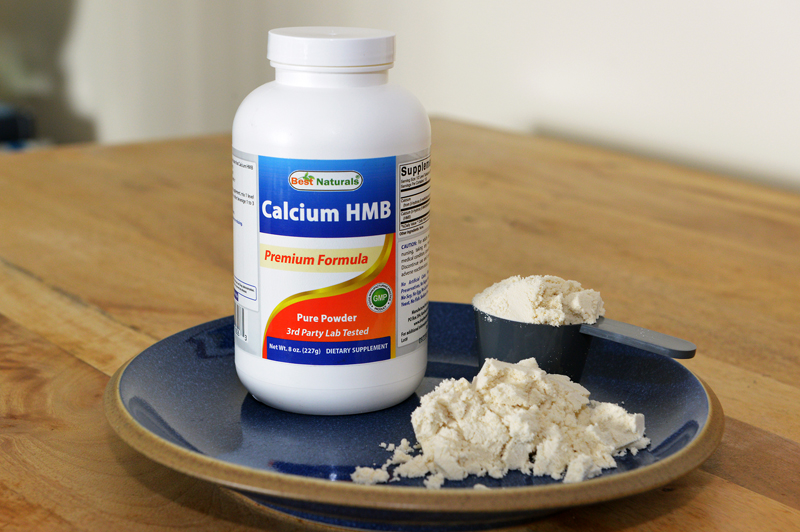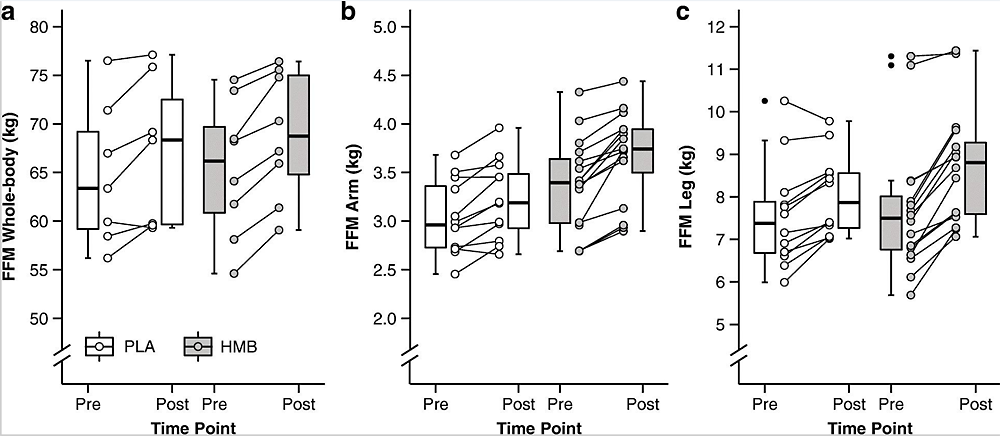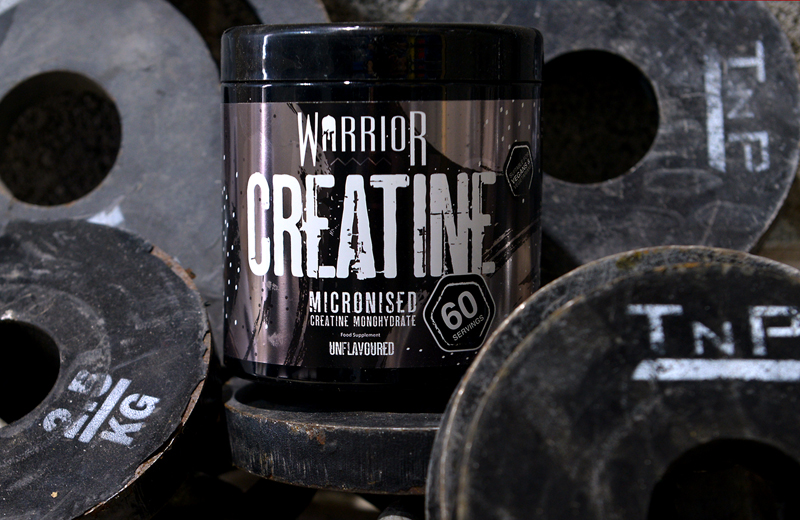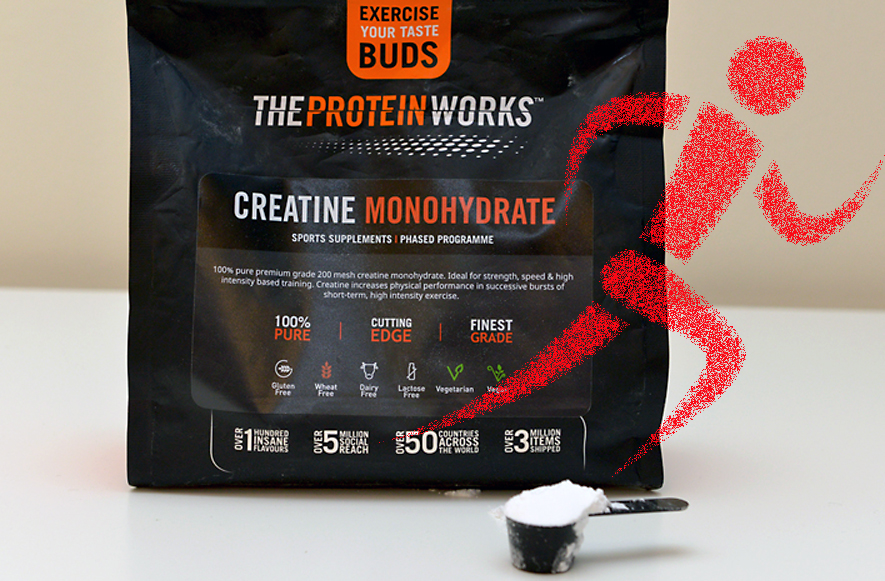HMB – An old kid is back on the block!
Over the past five years, there’s been a resurgence of interest in the strength supplement HMB. SPB highlights the most recent research and why it matters, and also explains why HMB might also help brain function in older athletes!
When it comes to muscle strength and post-exercise recovery, applying the right training stimulus and consuming the right day-to-day diet is essential. But beyond that, the correct post-training nutrition strategy is also critically important. As has been highlighted in a number of previous SPB articles, numerous studies have shown beyond doubt that feeding protein shortly after training increases muscle synthesis. However, we now know that growth only occurs with ingestion of the essential amino acids(1) and that one amino acid in particular called leucine is particularly important.
Leucine, muscle growth and recovery
Given that there are eight essential amino acids required to synthesize protein in the body, why is it that leucine plays a special role? The reason is that leucine seems to stimulate the metabolic pathways inside muscle cells that result in increased muscle protein synthesis following intense exercise(2,3). Therefore, proteins that digest quickly and which are rich in leucine (for example whey protein) are ideal for post-exercise feeding. (NB consuming carbohydrate along with protein appears to help increase the uptake of amino acids into the muscle from the protein(4,5), which is why most ‘recovery’ and ‘weight gain’ drinks provide varying amounts of carbohydrate along with the protein.)
However, in addition to the proven benefits of leucine when consumed in proteins such as whey, scientists have also invested time and effort investigating the precise role of leucine itself in muscle growth, and in particular, the potential benefits of compounds that occur naturally in the body when leucine is metabolized. This role (of leucine in muscle growth) is still not well understood but seems to entail the upregulation of muscle growth and synthesis pathways - particularly in circumstances when muscle breakdown would otherwise occur such as during/after intense prolonged exercise and in the infirm/elderly(6).
More precisely, leucine’s capacity to boost muslce protein synthesis is thought to occur by enhancing a biochemical pathway known as the ‘mTOR cell-signalling pathway’(7). By increasing levels of a signalling molecule called mTOR, muscle cells are instructed to synthesise more protein. Strangely however, it seems that giving additional leucine as a supplement following resistance exercise may not be particularly effective at boosting muscle synthesis over and above that produced by consuming high-quality, leucine-rich protein (such as whey) alone(6).
Close relatives of leucine
However, the leucine story doesn’t end there because some research indicates that some compounds produced naturally in the body when leucine is metabolised (ie leucine metabolites) have anabolic (muscle building) effects. One of these is β-hydroxy β-methylbutyrate – more commonly known as ‘HMB’ - which has been a popular choice over the years as an anti-catabolic supplement among some strength athletes and bodybuilders. In addition, there’s also been interest in another metabolite of leucine called alfa-hydroxy-isocaproic acid (HICA), which has been investigated as a potentially potent means of building and maintaining muscle mass.
Of these two close leucine relatives, it is HMB that is widely used by bodybuilders and athletes as a muscle/strength building supplement. A solid body of early research suggested that supplementing 1.5-3.0g per day of HMB can increase muscle mass and strength, particularly in untrained subjects beginning training, and especially in those who are more elderly(8-14). The muscle mass gains in these studies were typically 0.5-1.0kg greater than for controls during 3 – 6 weeks of training.
HMB in athletes
Despite these earlier positive findings, doubts about the strength benefits of HMB for already trained athletes have remained. There’s some evidence that HMB might exert a protective effect by ameliorating exercise-induced muscle damage in athletes. For example, in one study, runners who took 3g of HMB per day for 6 weeks and then completed a 20k run had much lower post-run levels of creatine phosphokinase and lactate dehydrogenase levels (both measures of muscle damage) than a placebo group who took no HMB, indicating that the HMB had helped to ameliorate muscle damage caused by the run(15).
However, other studies have drawn a blank on the use of HMB (and HICA). For example, Portuguese scientists investigated the effects of off-the-shelf leucine metabolite supplements muscle volume and strength during an 8-week resistance training protocol(16). Fifty-three strength-trained participants were allocated into four groups who took the following leucine metabolite supplements or placebo for eight weeks while also consuming a high-protein, leucine-rich diet:
· Alpha-hydroxyisocaproic acid ([α-HICA]
· Beta-hydroxy-β-methylbutyrate free acid ([HMB-FA]
· Calcium β-hydroxy-β-methylbutyrate
· An inert placebo (control condition)
After eight weeks of training, all the four groups reported strength gains. However, none of the leucine metabolite supplemented groups showed any extra strength or muscle mass gains/improvements in body composition compared to the group that took the placebo. In short, when the diet was already high in leucine-rich proteins such as whey, none of the leucine metabolite supplements produced any significant extra gains.
Most recent HMB research
In the last five years of so, the rate of research into HMB supplementation has accelerated markedly. Most of this impetus for new HMB research has come from the sphere of medicine. That’s because of an increasing awareness of the potential of HMB to help ameliorate muscle mass loss and accelerate recovery in those who are elderly and infirm, suffering from traumatic injuries, recovering from surgery or suffering from chronic and serious diseases such as kidney and liver disease, and certain types of cancer(17-20).
While much of the most recent HMB research has focussed on its medical benefits, there’s been a knock-on effect because a number of recent HMB studies have also revisited its use for athletic performance, and come up with very intriguing results. Take muscle damage for example; a review study published at the end of last year pooled the data on HMB supplementation and exercise induced muscle damage (EIMD)(21). It found that HMB supplementation can be considered as an effective nutritional strategy for reducing EIMD provided that 3 grams per day of HMB is taken for at least two weeks prior to exercise and the daily dose is split up (3 × 1g taken at breakfast, lunch, and dinner).
Another review study published just last month looked at nutritional interventions to reduce EIMD(22). Fifty-three randomized controlled trials evaluating 24 nutritional interventions on 10 different outcomes were analyzed, and one of these interventions was HMB supplementation. The results revealed a significant post-exercise reduction in a key marker of muscle damage called creatine kinase when HMB was consumed prior to exercise, indicating that less muscle damage was occurring.
HMB and muscle function
One of the main challenges for an older athlete is the aging-related loss of muscle mass and strength that inevitably occurs as the years tick by. With this in mind, a 2020 study sought to determine whether supplementation with HMB (along with extra and vitamin D3) would enhance muscle function and strength in older adults undertaking a resistance program(23). It also included a matched group of adults who took supplements but did not resistance train.
This study evaluated 117 participants using multiple measurements over a 12-month period, which included body composition, muscle strength & functionality, and questionnaires. The results showed that supplementing three grams per day of HMB (plus 2,000IUs of vitamin D3) per day resulted in muscle mass and strength gains regardless of whether the subjects were training or not! While not providing solid evidence that HMB supplementation can enhance performance, this study does suggest that athletes (especially older athletes) who are forced to take a break from training (eg through injury) might well benefit from supplementing HMB during periods of inactivity.
Another 2020 study compared men undergoing a 12-week resistance program who supplemented either whey protein plus placebo (ie whey alone) or whey protein plus three grams of HMB per day(24). The results showed that taking HMB along with whey protein resulted in significantly greater lean muscle mass gains in the legs (and almost significantly gains in the arms) compared to just supplementing whey protein alone (see figure 1). In plain English, HMB supplementation enabled greater muscle mass gains, but only in the exercising limbs. However, when analyzed across the whole body, the extra gains produced by HMB were not large enough to be significant.
Figure 1: Whey-only vs. whey plus HMB and fat-free mass
Open bars = whey only; shaded bars = whey plus HMB. The difference in muscle mass gains was significantly greater in the whey plus HMB group compared to whey only when analyzing legs (figure c on the right). There was a trend to more muscle mass for whey plus HMB when analyzing arms (b) but no trend when analyzing whole body muscle mass (a).
The findings above might help explain why other studies into whey protein vs. whey + HMB supplementation have drawn a blank – because measurements of whole body muscle mass might obscure the limb-specific gains in arms and legs. A 2019 study suggests that HMB doses used are also very important. The current consensus seems to be that 3g per day in divided doses is recommended. But in a 12-week study on resistance trained men, scientists compared whey supplementation alone vs. whey plus HMB(25) (very much like the study above) – but this time the dose was just 1.5 grams per day. These results showed that HMB given along with whey did not result in greater increases in any measure of muscle mass or strength compared to leucine added to whey.
Mind-blowing properties of HMB
Although there are still many uncertainties about HMB supplementation, the more recent research suggests that when taken at the right doses and at the right times, HMB may indeed offer athletes a distinct advantage, - especially in older athletes who need to maintain muscle mass and recover fast. However, there could be another reason to consider HMB supplementation and that’s to do with brain health. In a study by scientists at the Department of Neurological Sciences, Rush University Medical Center in Chicago, researchers have identified that due to its unique molecular structure, HMB may help protect memory, reduce plaques in the brain and ultimately help prevent the progression of Alzheimer’s disease(26).
Carrying out experiments on mice, the researchers were investigating why a family of proteins known as ‘neurotrophic factors’ are drastically decreased in the brains of people with Alzheimer’s disease. Neurotropic factor proteins have been found to help in the survival and function of brains neurons - cells that receive and send messages from the body to the brain and vice versa. When neurotropic factor proteins decline, brain health declines. The researchers found that after oral consumption of HMB, it enters into the brain to increase these beneficial proteins, helping to restore neuronal connections. In the mice studied, oral HMB supplementation improved memory and learning. It also reduced the amount of plaques and tangles in mice with Alzheimer’s-like pathology.
As to the mechanism behind this protective effect, it seems that HMB stimulates a hormone receptor called ‘peroxisome proliferator-activated receptor α’ (PPARα) within the brain. The hormone regulates the uptake and transport of fatty acids in the brain. Since these fatty acids are a key component of brain neurons, any impairment of fatty acid metabolism in the brain disrupts neurone integrity, with devastating results. By stimulating PPARα HMB thereby helps protect neurons from degradation and malfunction. Indeed, in these mouse experiments, adding HMB to the diet actually reversed the amount of plaque formation in the brain, enabling the mice to regain learning and memory functions!
The researchers went onto explain that if the mouse dose of HMB (5-10mg per kilo of bodyweight per day is translated to humans, a dose of 400-800mg of HMB per day may be beneficial to control and/or even reverse Alzheimer’s related symptoms and pathology – remarkable considering that there are currently no known drugs or methods to reverse Alzheimer’s!
Practical recommendations
Should you take HMB as a supplement or not? The research until recently was rather mixed, which made HMB a difficult supplement to recommend to athletes watching the purse strings - other than to elite athletes seeking every possible incremental gain. However, the most recent research, while not without question marks, certainly swings the pendulum somewhat back in favor of HMB supplementation.
Providing the dose is correct – 3g per day divided up into 3 x 1g doses through the day – there’s fairly good evidence that HMB can help reduce exercise induced muscle damage, thereby promoting recovery. This is particularly relevant for older athletes, who tend to suffer more EIMD anyway and take longer to recover. The same is true for muscle mass preservation, especially where older athletes need to take time off from training – due to injury or extended recovery after a demanding event.
Where muscle mass and strength gains are concerned in already trained athletes, the evidence is still quite mixed. In particular, where athletes already use copious amounts of leucine-rich whey protein to support training, the extra gains to be had from HMB supplementation may very minimal – ie not really noticeable for most athletes in most circumstances. The exception here might be with older athletes who train more irregularly, where supplemental HMB may help in muscle mass retention between workouts.
Overall then, given that HMB is not hugely expensive and has an excellent safety profile, it gets a qualified thumbs up, especially for older athletes. However, it shouldn’t been seen as ergogenic as say creatine or caffeine! Focussing once again on older athletes, the very latest findings on HMB and brain health are potentially very exciting. Given that around 6.5 million people in the United States aged 65 and older live with Alzheimer’s disease (the most common cause of dementia, where memory, thinking, behavior and social skills gradually deteriorate), if these early findings on HMB and neuron health can be confirmed in subsequent studies on humans, it would certainly make HMB supplementation a no-brainer (excuse the pun) for all older athletes!
References
1. Am J Physiol 1999; 276(4 Pt 1):E628-E634
2. J Nutr 1999; 129(6):1102-1106
3. Am J Physiol 1998; 274(2 Pt 1):C406-C414
4. Med Sci Sports Exerc 2003; 35(3):449-455
5. Med Sci Sports Exerc 2006; 38(4):667-674
6. J Nutr 2005; 135(6 Suppl):1580S-1584S
7. J Nutr. 2001; 131(3), 856S-860S
8. Med Sci Sports Exerc 2000; 32(12):2109-15
9. Med Sci Sports Exerc 2000; 32(12):2116-9
10. J Appl Physiol 1996; 81(5):2095-104
11. Nutrition 2000; 16(9):734-9
12. Sports Med 2000; 30(2):105-16
13. Nutr 2000; 130(8):1937-45
14. J Nutr 2001; 131(7):2049-52
15. Nutr 2000; 130(8):1937-45
16. Applied Physiology, Nutrition, and Metabolism June 2021. Volume 46, Number 6
17. Curr Opin Clin Nutr Metab Care. 2022 Mar 1;25(2):88-92
18. J Cachexia Sarcopenia Muscle. 2022 Oct;13(5):2265-2275
19. J Cachexia Sarcopenia Muscle. 2022 Jun;13(3):1623-1641
20. JPEN J Parenter Enteral Nutr. 2023 Jun 25. doi: 10.1002/jpen.2527. Online ahead of print
21. Phys Act Nutr. 2022 Dec;26(4):41-45
22. Nutr Rev. 2023 Jul 17;nuad078. doi: 10.1093/nutrit/nuad078. Online ahead of print
23. J Gerontol A Biol Sci Med Sci. 2020 Oct 15;75(11):2089-2097
24. J Int Soc Sports Nutr. 2020; 17: 16
25. Med Sci Sports Exerc. 2019 Jan;51(1):65-74
26. Muscle-building supplement β-hydroxy β-methylbutyrate binds to PPARα to improve hippocampal functions in mice. Cell Reports, 2023; 112717 DOI: 10.1016/j.celrep.2023.112717
Newsletter Sign Up
Testimonials
Dr. Alexandra Fandetti-Robin, Back & Body Chiropractic
Elspeth Cowell MSCh DpodM SRCh HCPC reg
William Hunter, Nuffield Health
Newsletter Sign Up
Coaches Testimonials
Dr. Alexandra Fandetti-Robin, Back & Body Chiropractic
Elspeth Cowell MSCh DpodM SRCh HCPC reg
William Hunter, Nuffield Health
Keep up with latest sports science research and apply it to maximize performance
Today you have the chance to join a group of athletes, and sports coaches/trainers who all have something special in common...
They use the latest research to improve performance for themselves and their clients - both athletes and sports teams - with help from global specialists in the fields of sports science, sports medicine and sports psychology.
They do this by reading Sports Performance Bulletin, an easy-to-digest but serious-minded journal dedicated to high performance sports. SPB offers a wealth of information and insight into the latest research, in an easily-accessible and understood format, along with a wealth of practical recommendations.
*includes 3 coaching manuals
Get Inspired
All the latest techniques and approaches
Sports Performance Bulletin helps dedicated endurance athletes improve their performance. Sense-checking the latest sports science research, and sourcing evidence and case studies to support findings, Sports Performance Bulletin turns proven insights into easily digestible practical advice. Supporting athletes, coaches and professionals who wish to ensure their guidance and programmes are kept right up to date and based on credible science.












